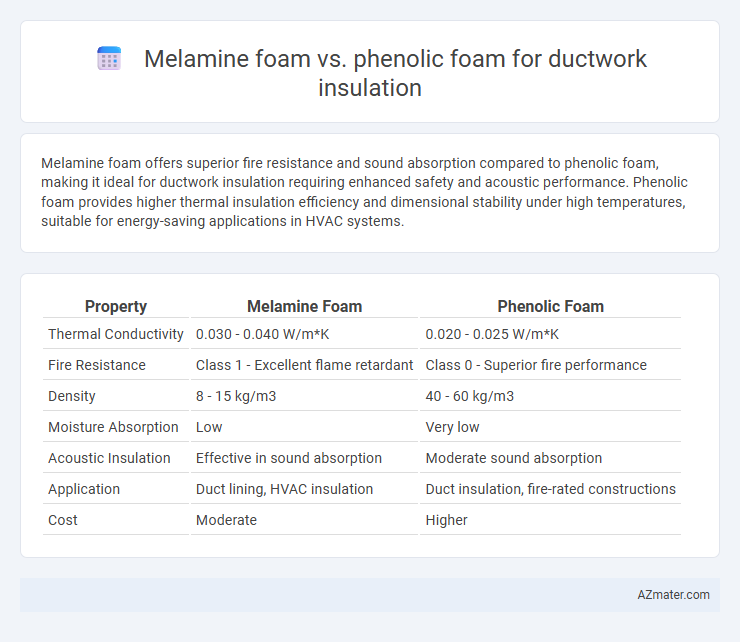Melamine foam offers superior fire resistance and sound absorption compared to phenolic foam, making it ideal for ductwork insulation requiring enhanced safety and acoustic performance. Phenolic foam provides higher thermal insulation efficiency and dimensional stability under high temperatures, suitable for energy-saving applications in HVAC systems.
Table of Comparison
| Property | Melamine Foam | Phenolic Foam |
|---|---|---|
| Thermal Conductivity | 0.030 - 0.040 W/m*K | 0.020 - 0.025 W/m*K |
| Fire Resistance | Class 1 - Excellent flame retardant | Class 0 - Superior fire performance |
| Density | 8 - 15 kg/m3 | 40 - 60 kg/m3 |
| Moisture Absorption | Low | Very low |
| Acoustic Insulation | Effective in sound absorption | Moderate sound absorption |
| Application | Duct lining, HVAC insulation | Duct insulation, fire-rated constructions |
| Cost | Moderate | Higher |
Overview of Ductwork Insulation Materials
Ductwork insulation materials such as Melamine foam and Phenolic foam offer distinct thermal and acoustic benefits. Melamine foam provides excellent sound absorption and fire resistance while maintaining a lightweight structure, ideal for reducing noise in HVAC systems. Phenolic foam delivers superior thermal insulation with high fire retardancy and low smoke emission, making it suitable for energy-efficient ductwork that meets stringent safety standards.
Introduction to Melamine Foam
Melamine foam is a highly effective insulation material commonly used in ductwork for its excellent sound absorption and thermal resistance properties. It features a lightweight, open-cell structure that provides superior fire resistance and low smoke emissions compared to phenolic foam. Melamine foam also offers enhanced durability and environmental benefits, making it a preferred choice in HVAC insulation applications.
Introduction to Phenolic Foam
Phenolic foam is a high-performance insulation material widely used in ductwork insulation due to its excellent thermal resistance and fire-retardant properties. It features a closed-cell structure that provides superior moisture resistance and low smoke emission compared to melamine foam. With a lower thermal conductivity ranging from 0.020 to 0.028 W/m*K, phenolic foam enhances energy efficiency and meets stringent building codes in HVAC systems.
Thermal Insulation Performance Comparison
Melamine foam offers excellent thermal insulation with low thermal conductivity around 0.035 W/m*K, making it highly effective for ductwork insulation, especially in environments requiring fire resistance and sound absorption. Phenolic foam typically exhibits thermal conductivity values between 0.020 and 0.030 W/m*K, providing superior thermal insulation performance compared to melamine foam, alongside excellent fire resistance and dimensional stability. The choice between melamine and phenolic foam for duct insulation hinges on balancing thermal insulation efficiency with factors like fire rating, moisture resistance, and mechanical durability.
Fire Resistance and Safety Credentials
Melamine foam offers superior fire resistance due to its inherently low flammability, high thermal stability, and compliance with stringent safety standards such as ASTM E84 Class A ratings, making it ideal for ductwork insulation in high-risk environments. Phenolic foam also provides excellent fire retardant properties, featuring low smoke emission and self-extinguishing behavior, but typically exhibits a higher smoke density compared to melamine foam, which can be critical in confined duct spaces. Both materials meet key fire safety codes, but melamine foam's enhanced fire and smoke performance often positions it as the preferred choice for applications demanding rigorous fire protection and safety credentials.
Acoustic Properties and Noise Control
Melamine foam offers superior acoustic absorption with an open-cell structure that effectively reduces airborne noise and reverberation inside ductwork. Phenolic foam, although providing excellent thermal insulation, has a closed-cell composition that limits its noise reduction capabilities in comparison. For enhanced noise control in ductwork insulation, melamine foam is generally preferred due to its higher sound absorption coefficient and better performance in mitigating HVAC system noise.
Moisture Resistance and Durability
Melamine foam offers superior moisture resistance compared to phenolic foam, making it ideal for ductwork insulation in humid environments where water absorption can compromise performance. Phenolic foam provides excellent durability with high compressive strength and thermal stability but tends to degrade when exposed to prolonged moisture. Choosing melamine foam ensures longer-lasting insulation effectiveness by preventing mold growth and maintaining structural integrity under damp conditions.
Installation Process and Flexibility
Melamine foam offers superior flexibility for ductwork insulation, enabling easy contouring around irregular shapes and tight spaces without damaging the material. Its lightweight and open-cell structure simplifies the installation process, reducing labor time and effort compared to rigid phenolic foam. Phenolic foam, while providing excellent thermal resistance, tends to be more brittle and requires precise cutting and fitting, making installation more labor-intensive and less adaptable to complex duct configurations.
Environmental Impact and Sustainability
Melamine foam offers superior environmental benefits due to its low smoke toxicity and high recyclability, reducing harmful emissions during both production and disposal compared to phenolic foam. Phenolic foam, while effective in thermal insulation and fire resistance, involves more energy-intensive manufacturing processes and often contains formaldehyde-based binders, raising concerns about off-gassing and long-term environmental impact. Choosing melamine foam for ductwork insulation can contribute to better indoor air quality and lower carbon footprint, aligning with sustainable building practices.
Cost Analysis and Long-Term Value
Melamine foam offers moderate initial costs with excellent noise reduction but tends to be pricier than phenolic foam, which is often favored for its lower upfront price and superior thermal insulation. Phenolic foam's closed-cell structure provides higher fire resistance and durability, translating to longer service life and reduced maintenance expenses, enhancing long-term value. When evaluating ductwork insulation, phenolic foam generally presents a better cost-benefit balance through extended insulation performance and energy savings.

Infographic: Melamine foam vs Phenolic foam for Ductwork insulation
 azmater.com
azmater.com